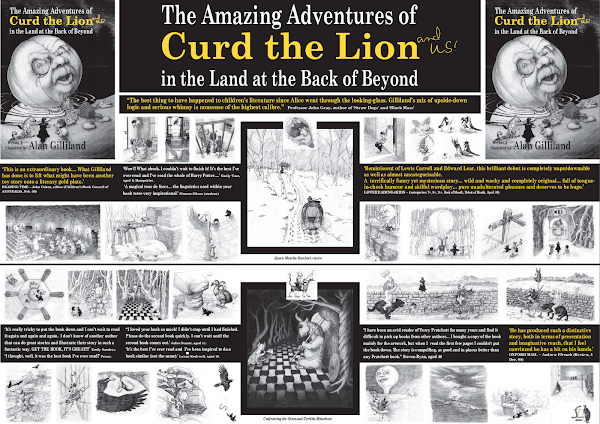An article in Guardian* yesterday reiterating one from the New York Times** quotes Maurice Sendak (new book coming out, “Bumble-Ardy,”) as saying that children’s books are too safe and that modern children's books are not always "truthful or faithful to what's going on with children". "You mustn't scare parents. And I think with my books, I managed to scare parents," said Sendak.
Read articles here:
*http://www.guardian.co.uk/books/2011/sep/19/childrens-books-not-wild-maurice-sendak?
**http://artsbeat.blogs.nytimes.com/2011/09/16/on-the-phone-with-maurice-sendak/#preview
My first book, out in the UK (not US), ‘The Amazing Adventures of Curd the Lion (and us!) in the Land at the Back of Beyond’ is definitely perceived by some adults as far too scary to allow their children access (even though it is a nonsense quest story), while children (all those I’ve heard from) love it and see nothing wrong with a bit of scariness.
Quote (from Bookwitch review responses) –
ab | March 16, Reply: “Sounds and looks intriguing, and those wonderful details such as the snake travelling wrapped around the neck of the – what is it – a hyena? Delightful!
But isn’t it perhaps mainly for grownups who admire the artistry? I would be scared to death by it as a child because of the sinister and foreboding atmosphere in the pictures. And who is so cruel as to threatens to give away children’s toys? The kids in the corner – it reminds me of dictatorships and torture…. brrrr.”
bookwitch | March 16, Reply: “I find I get more scared the older I get. Most children are quite ‘unfeeling’ in some way. And Alan has had lots of satisfied customers, I gather. Of the small variety.
But yes, the mother was a bit over the top with her threat. And so was that woman who wanted to eat Hansel and Gretel.”
Quote (from Bookwitch review responses) –
ab | March 16, Reply: “Sounds and looks intriguing, and those wonderful details such as the snake travelling wrapped around the neck of the – what is it – a hyena? Delightful!
But isn’t it perhaps mainly for grownups who admire the artistry? I would be scared to death by it as a child because of the sinister and foreboding atmosphere in the pictures. And who is so cruel as to threatens to give away children’s toys? The kids in the corner – it reminds me of dictatorships and torture…. brrrr.”
bookwitch | March 16, Reply: “I find I get more scared the older I get. Most children are quite ‘unfeeling’ in some way. And Alan has had lots of satisfied customers, I gather. Of the small variety.
But yes, the mother was a bit over the top with her threat. And so was that woman who wanted to eat Hansel and Gretel.”
From an Amazon reviewer: “From the TERRIFYING front cover, I was worried that this book would be too frightening for a young audience - however, I was completely wrong.” and, “the Minorbore AXING you??”
From kids, though: “The best part (to me) is probably when Sweenie "pondered" and brought down the hilarious Balloonafuss, that utterly baffles them!” and “Here's one of my drawings of a Minobour!”
It is PC (protective custody) adults who decide that a book is too scary for their kids – I’ve never had a complaint from a child. Perhaps Maurice Sendak is right about today’s coddled-childhood in publishing: my book was self-published, yet has sold nearly 8,000 at £15 in hardback in the UK (80 pencil illustrations in160p. story) with plenty of very enthusiastic kids reviews.






